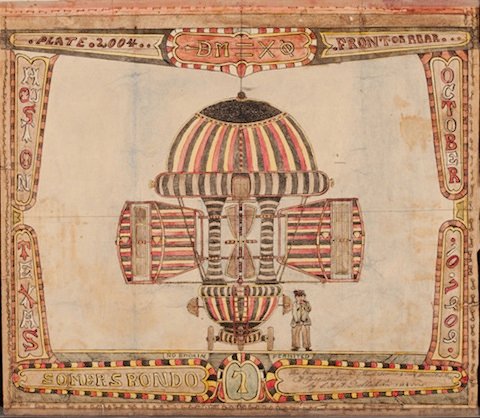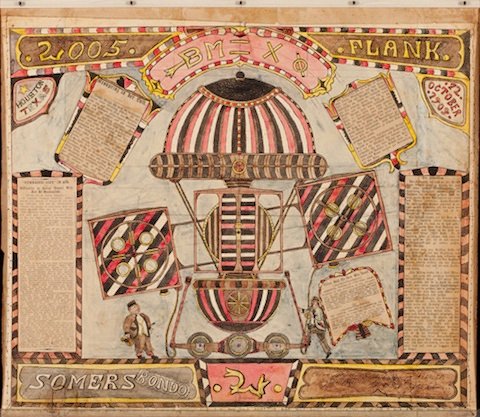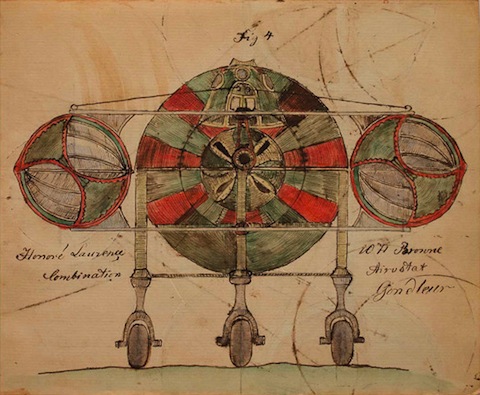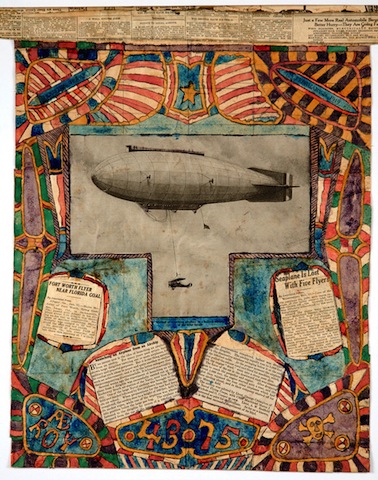
The art of Charles Dellschau has been receiving some attention lately, thanks to the recent publication of a book about his work. Dellschau, who produced thousands of strange and wonderful watercolours, drawings and collages in Houston, Texas, between about 1899 and 1922, is significant as an early outsider artist, but he is mainly of interest to me for two things. Firstly, his subject matter: his artwork is filled with strange flying machines (balloons? airships? aeroplanes?) intermingled with press clippings about aviation. Secondly, his overarching narrative: that his artwork records the activities of the Sonora Aero Club, a secret group of airminded inventors who actually created and flew the aircraft he depicted in California in the mid-nineteenth century. This is a beguiling idea, and some of Dellschau’s admirers have tried to find out whether it is actually true (such as Pete Navarro, who is largely responsible for rescuing Dellschau’s work). The Atlantic describes it as ‘The Amazing Story of an Airship Club That Might Never Have Existed’, as though we should be surprised if it had not. But it seems abundantly clear to me that we can in fact say that it pretty much definitely never existed. There is no evidence for the Sonora Aero Club that does not appear in Dellschau’s artwork, but plenty against it elsewhere in the historical record.

Dellschau claimed to have been the Aero Club’s draughtsman. He was a German immigrant, born in Prussia in 1830. He came to the United States in 1853, where he worked for most of his life as a butcher. Through his art he claimed that, sometime in the 1850s, he was in California where he was the Aero Club’s draughtsman. This is roughly when, according to Dellschau, the Sonora Aero Club was active. It was disbanded in the 1860s due to the death of Peter Mennis, an inventor and pilot as well as discoverer of a ‘Lifting Fluid’ variously called ‘NB gas’ or ‘supe’ or ‘suppe’ or ‘suppa’. When Mennis died the secret of suppa and flight itself was lost with him. Cynthia Greenwood’s 1998 article in the Houston Press gives an idea of the Aero Club’s activities and achievements:
[Dellschau] illustrates a remarkable number of designs — maybe as many as 100 — for airships with names such as Aero Mio, Aero Trump, Aero Schnabel and Aero Mary. (There’s even an Aero Jourdan.) All were powered by a secret formula that Dellschau called both “supe” and “suppe”; it could both negate gravity and drive the ships’ wheels, side paddles and compressor motors.
One drawing tells the story of Adolf Goetz’s Aero Goeit, recklessly commandeered by an unskilled pilot; the airship got tangled in a Sequoia tree, and the interloper died of a broken neck. Another cautionary tale involves Jacob Mischer, a pilot who went down in flames in the Aero Gander; Dellschau hints that he was sabotaged by other club members, who suspected him of using the aircraft to make money by hauling cargo.
But most of the airships’ flights were safe — and great fun. Dellschau depicts his aviators enjoying hot breakfasts, and delights in enumerating the ships’ clever gadgets. He often bedecked his watercolor paintings with little press clippings — from Scientific American, the Houston Chronicle and an unidentified German-language newspaper — that recount air disasters; Dellschau called them “press blooms.” Against paintings of the Sonora club’s successes, the clippings seem intended as an ironic counterpoint.
Dellschau never seems to explain why the club worked so hard to protect its secrecy, but he shows the members going to great lengths to do so. By day, the Aero Goeit was disguised as a gypsy wagon, so it could travel open roads undetected. Dellschau writes that a club member was banned from developing a machine because he’d talked to outsiders. And of course, even years after the club disbanded, many of Dellschau’s own comments are rendered in code. Apparently, whatever it was that he had to say was too private even for his own notebooks.
The first and most obvious thing to note is that the capabilities of these aircraft are far in advance of the technology of the day. The first airship flight was made by Henri Giffard in France in 1852; with only three horsepower and a speed of about six miles an hour it was unable to fly into the wind. His subsequent attempts to build bigger and more powerful airships failed. A decade later, in what is perhaps the closest known parallel to Dellschau’s Aeros, Solomon Andrews flew the Aereon, a weird balloon/airship hybrid with three gas envelopes, over Perth Amboy, New Jersey. At about the same time, according to Dellschau, the Sonora Aero Club had perfected controlled, powered, lighter-than-air flight and many of its machines were secretly flying in California’s skies — after which they disappeared, leaving no trace in the documentary record. This is incredible and in fact not credible.

The ‘aeros’ themselves look not much like any real airships that flew later; they are more spherical than elongated and so not streamlined. (It’s tempting to read the image at the top of this post as showing an airship from the front and below, but comparing it with his other paintings in fact it’s a side, or ‘Flanck’ in Dellschau’s idiosyncratic English, view.) Then there’s the ‘Lifting Fluid’, suppa, with its wonderful properties. There are only a few possible lifting gases, and the only ones not discovered by the 1850s are neon (which is only just viable) and (much better) helium, both of which are very rare on Earth and difficult to extract. It’s conceivable that they could have been discovered earlier than we currently believe, but it would require a substantial of resources to produce enough for use in airships (as is well known, Germany was forced to use hydrogen for its airships in the 1930s due to a US embargo on helium exports). And again, we would then have to accept that this discovery was then forgotten for decades, like the secret of the aeros themselves. The improbabilities are piling up alarmingly.

The artwork apart, there doesn’t seem to be much evidence that Charles Dellschau even lived in California, though his whereabouts are unknown between 1856 and 1860 so it’s possible he was there during those years. Some of the names he mentioned as Aero Club members can be found in California a few decades later, or more troublingly in Texas. (A Peter Mennis fought in the Mexican-American War in 1846-8 but he died in 1901.) There’s no definitive evidence here either way, though people have looked. What we do know is that Dellschau began working on his images at the end of the 1890s and into the early 1920 (though most of the earlier ones were lost, so we don’t know what they contained). So, whether he was involved in any secret aeronautical work in the 1850s or not, he was creating his art in the decades when controlled flight was becoming practical and doing so in a very public way. Some of the seemingly prescient details on his aircraft can be explained this way, such as undercarriages with what look like pneumatic tyres, not invented until 1888 (see the following image, apparently from Dellschau’s diary rather than his notebooks; though the style looks quite different). And he was clearly very aware of contemporary developments in flight: he literally incorporated aviation news into his work.

Another problem is the name ‘Sonora Aero Club’ itself. There were (and still are) many aero clubs around the world: the Royal Aero Club, the Aero Club of America, the Aéroclub Royal de Belgique, and so on. It’s one of the few uses of ‘aero’ left other than as a prefix. But using Google Ngram Viewer and Bookworm we can see that the vogue for aero clubs can be dated to around 1900, that is shortly after the first (known) aero club was formed in 1898, the Aéro-Club de France. It would be a remarkable coincidence if the Sonorans just happened to hit upon the same name that everyone else decided to start using more than four decades later, and at just about when Dellschau started on his masterwork too.

Attempts have been made to link the Sonora Aero Club to the mystery airships seen in many parts of the United States in 1896 and 1897. At first blush this seems reasonable: if the mystery airships were real then there must have been mystery airship inventors who, like the Sonorans, worked in secret. Maybe the Aero Club survived after all, or maybe NYMZA, the secret society of which it was but one part, continued its aeronautical researches. But this is to explain one fantasy with another. While I’ve yet to look at American mystery aircraft scares (though that’s not quite the right word, as there was little fear; manias is perhaps better) in detail, they appear to be largely misperceptions informed by culture and imagination just like the similar scares in Britain, Australia, and elsewhere. It’s more likely that the mystery airship reports led to the Sonora Aero Club rather than the other way around; again, they were in the news only a few years before Dellschau started drawing and painting his weird airships. At any rate, like the mystery airships, Dellschau’s airships were responses to the dawn of flight around the turn of the twentieth century, though an individual one, not a collective one. It was art, not history.
Image sources: Atlantic; Observatory.
![]() This work is licensed under a Creative Commons Attribution-NonCommercial-NoDerivatives 4.0 International License.
Permissions beyond the scope of this license may be available at http://airminded.org/copyright/.
This work is licensed under a Creative Commons Attribution-NonCommercial-NoDerivatives 4.0 International License.
Permissions beyond the scope of this license may be available at http://airminded.org/copyright/.


Odd but true I just found out about the Sonoma Aero Club living here in Northern California… Sonora is just down the Sierras a bit from me in the Grass Valley Area… the 1897 mystery airships also have been attributed to an early aviation inventor here.. my research leads that way for sure… he fired the lawyer who gave away the hint of where he was… I am speaking of Lyman Gilmore jr. and his brother Charles Gilmore both gold miners/mine owners from Grass Valley, Ca…. the gas called NB is a common chemical element used in the mines at that time normally… just not common or “invented” outside the mines at that time… it can be made in the air..!! the point of the 1897 flights was to obtain publicity for the US Army air observation contracts… $50,000… the Wrights were also in line for that and politics made sure they got it… the NB/Suppe system is still used in jet aircraft today and the “secret” stayed just that a secret… until they retired the SR-71..? all the secrecy is based on the “Skunk Works” facility… this NB gas is not used in stealth aircraft however… one the main designers at the Skunk works Ben Rich there was a big Lyman Gilmore jr. fan…. wish we could ask him why but RIP… great article…
Thank you for your kind words, but I don’t believe anything about the Sonora Aero Club is true. Lyman Gilmore was one of many aviation pioneers from around the turn of the century who built an aeroplane that couldn’t fly — oddly, a whole generation after the Aero Club was supposedly disbanded. There is no chemical element called NB, and it makes no scientific sense. The Wright brothers were not ‘in line’ for any US Army contracts; they had a long struggle to convince anyone to buy their flyer. Aircraft today do not fly using NB; they use aerodynamics. It’s all nonsense. What the Sonora Aero Club does tell us something about is the cultural appeal of aviation in the early 20th century, not secret flights in the late 19th century.
Yep ok… did the Balloonists trained by Peter Mennis become the Army balloon Corp. that fought in the civil war with Thaddeus Lowe…? is that why the SAC… was moved out in about 1860… some spoke German as was Thaddeus Lowes group… and the gas was made with hydrochloric acid and iron bars like the old French balloonists..? Discovered 1830… Thaddeus sent Count Zepplin to his German speaking Corp members and they let out his methods for making the gas… he said he regretted that also… Lyman Gilmore was harping on making sure the airplanes whatever they were had Zepplin engines… run on hydrogen… He had a bi- gas radial… Hydrogen and steam turbines both… Imagine afterburners in the late 1890’s… but we shouldn’t go there… he did fly… He shoved off a granite shelf near my location that I know of… 6,100 ft…. got a picture of himself passing above that attitude… again Zepplins.. they fly above that attitude… yes all lost… Lyman’s family says the Smithsonian now admits he sent it in… Ben Rich papers is a goldmine so to speak… ask the Wright Brothers if they trust the Smithsonian…
What you say here is contrary to what we know about aviation history; it’s a mass of unanswered questions, unverified claims and non sequiturs. But sure, why not.
1. Since there seems to be no evidence that Peter Mennis ever existed (at least no Peter Mennis that corresponds to Dellschau’s account), then there’s no evidence that he trained any ‘Balloonists’. Anyway, the aircraft supposedly operated by the Sonora Aero Club were not balloons; conversely, Lowe’s balloons do not require any advanced technology to explain.
2. Some of Lowe’s balloonist spoke German; so what? There were many German-born immigrants in the United States, about 1.3 million in 1860 (out of a total population of 31 million, or 1 in nearly 24).
3. Yes, Lowe’s balloons used gas generated from iron filings and sulfuric (not hydrochloric) acid. What you’ve failed to mention is that this gas was ordinary hydrogen gas, which was discovered nearly a century before (Cavendish, 1766) – it’s not suppe or NB gas or whatever that is supposed to be. (What was special about Lowe’s gas was the fact that he devised a mobile generator to produce it, which was essential for balloon operations on campaign.)
4. Zeppelin was inspired by his balloon flight with one of Lowe’s men, Steiner (yes, a German immigrant). I’m not sure why you think Zeppelin got the secret of Lowe’s ‘gas’ this way or that Lowe ‘regretted’ this; where is your evidence? Again, there was nothing special about Lowe’s gas; it was just hydrogen. There was nothing special about the gas Zeppelin later used in his airships, either; that was hydrogen too. He didn’t need Lowe to tell him how to make it; the German chemical industry could produce abundant supplies.
5. I don’t know where you get your information about Lyman Gilmore, or what a ‘bi-gas radial’ is for that matter. His aeroplane used steam power – not steam turbines, or gas turbines, or some combination of both. There is no connection between Gilmore and Zeppelin. You seem to imply that Zeppelin engines ran on hydrogen – you might be thinking of the Graf Zeppelin, which did have engines capable of using gas as a fuel; experiments with hydrogen gas were unsuccessful and it ended up using blau gas (similar to propane). But that was in 1929; earlier Zeppelins used petrol or diesel. Where is this photograph of Gilmore flying above 6100 feet? (So what if Zeppelins fly above that altitude?) Have you looked at Ben Rich’s papers in the Huntingdon Library? What do they say that is relevant and where do they say it? Finally, it’s well-known that for many years the Smithsonian downplayed the Wrights’ achievements in favour of Langley’s Aerodrome. The history of early flight is littered with similar claims for priority – like Gilmore’s. If there is no evidence, why should any of them be believed?
Pingback: Up, Up and Away! | Weewarrior's Weblog
Pingback: Walter Bosley | NYMZA, The Sonora Aero Club, & The Origins of the Breakaway Civilization • The Higherside Chats
John Myers, you know more about the truth of Lyman, brother Charles, his wealthy gold-mining uncle, and friends than most others. His family were long-standing members of the I.O.O.F., and he was a member of the fraternity of gold miners in northern California. You’ve clearly done some good research. A more thorough search would reveal some of Lyman’s other creations (beyond his airship), including special designs for steam engines and steam directional transmissions, among others. He was using hydrogen gas for lift like others, but his craft had its own electrolyzer (making long-distance flight practical), and he designed a special inner reservoir into his aluminum air bag into which he could store compressed H gas for use in controlling the altitude of flight, and possibly fuel for a hydrogen-powered engine of his own design. I could share more, but our friend wants evidence, and I am not yet ready to publish…